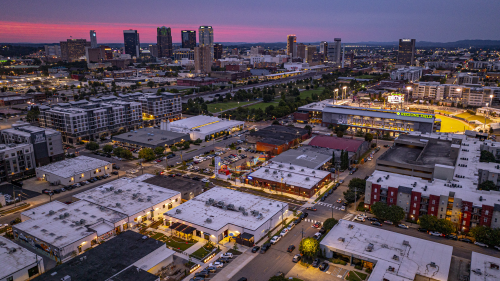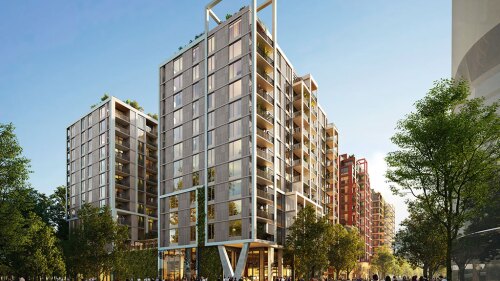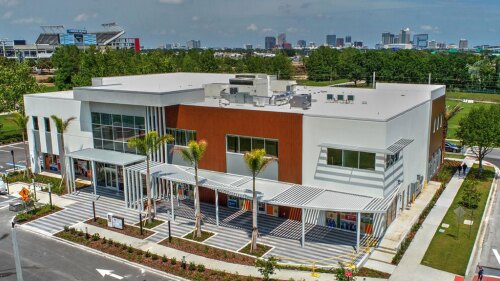Property Types
Hotels and Resorts
The hotel industry in the United States faces complex challenges in 2025, according to Jan Freitag, national director of hospitality analytics for the CoStar Group. During the “State of the U.S. Hotel Industry” presentation at the ULI 2025 Spring Meeting in Denver, Colorado, Freitag highlighted the challenges facing the hotel business amid macroeconomic uncertainty.
Once a sprawling expanse of uncharted land, Las Vegas, Nevada, has evolved into the entertainment capital of the world, a gaming super-hub, and a premier destination for sports. This remarkable transformation didn’t happen overnight; it stemmed from decades of strategic planning, investment, and visionary zoning recommendations.
Las Vegas is unlike any other place in America. Each year it draws more than 40 million visitors to the dazzling casinos and hotels that “turn night into daytime”—and transform the city into a glittering jewel in the desert. With 164,000 hotel rooms, Las Vegas is the largest hospitality market in the U.S.—outpacing Orlando, Florida, the next biggest market, by approximately 15 percent, according to JLL.
Industrial
Standing in the shadow of Regions Field and within earshot of Railroad Park, Birmingham’s Urban Supply hints at what the next chapter of downtown life could look like. Once-quiet brick warehouses are being steadily reimagined into patios, storefronts, and gathering spaces along a new pedestrian alley. Early tenants have begun to open their doors, and programming is slowly bringing people into the district. While the project is still in its early stages, the framework is in place for a vibrant hub that will grow block by block in the years ahead.
What trends are shaping the future of the industrial sector? Four experts from ULI’s Industrial and Office Park Development Council talk about the industrial submarkets and property types that offer the greatest opportunities, challenges developers face in bringing new projects to market, ways artificial intelligence and emerging technologies are reshaping the sector, tenant priorities, and other key trends.
After a quiet first half of 2024, CMBS originations increased 59 percent in Q3 on a year-over-year basis, according to the Mortgage Bankers Association’s Quarterly Survey.
Mixed-Use
Employing an approach that includes new development and adaptive use, and that leverages its solid economic base and strong job growth, Nashville, Tennessee, is seeing successful redevelopment of both its urban core and waterfront. Read how projects ranging from for-rent workforce housing to mixed-use development to a convention center are poised to drive continued economic development in Music City.
Six members of ULI’s three Small-Scale Development Councils speak about the advantages such developers have and the challenges they face in the current economy. Learn which retail tenant is the hardest to get approved, and why municipalities are taking a more favorable approach toward it.
It is unlikely that the boomers will be looking for traditional retirement housing for at least ten to 15 years. When they do, expect them to want a very different style and organization of seniors’ housing. Read more about what the new seniors will want in housing and how they will live differently that seniors of the past.
Multifamily
Making a significant move in the multifamily investment space, industry veteran Matt Ferrari officially launched PXV Multifamily, a private investment firm poised to acquire up to $2 billion in assets over the next 36 months. With a focus on both middle-market value-add properties and institutional-quality opportunities across the United States, PXV stands ready to capitalize on emerging market trends and challenges. Ferrari is an active member of the Urban Land Institute and the Multifamily Blue Flight Product Council.
In 2013, when the founders of Redbrick LMD looked over a large swath of land in Southeast Washington, D.C., they immediately connected with the breathtaking views of the U.S. Capitol, the Washington Monument, the Anacostia River, and expansive green space. They recognized that this kind of access was rare anywhere in the region, but especially in this often-overlooked corner of the city.
The evolution of community efforts to improve access to housing reveals that successful projects often hinge on fostering strong local partnerships that can provide essential supports and services.
Office
Envision Charlotte, a pioneering sustainability program in Charlotte, North Carolina, has partnered with Duke Energy, Cisco Systems Inc., and Verizon to produce a model program, Smart Energy Now. The program involves a robust network of 70 buildings, and their owners and managers, who will help achieve the program’s goals for dramatic energy savings. Up next: water, waste, and air. Charlotte will host ULI’s Spring Meeting, May 8-10.
The government’s data center consolidation efforts, cloud computing initiative, and budget constraints are creating opportunities for private data centers, attendees at one Bisnow Media event learned.
With a few tweaks to the development plan, Kai Tak—a decommissioned airport—can become the vibrant, mixed-use community the Hong Kong government wants it to be, says a ULI advisory services panel.
Residental
Affordable housing projects are often ground zero for the achievement gap that exists in the United States said panelists at the ULI Housing Opportunity conference. Nearly one in four American children (22 percent as of 2013) live in poverty, with half of those children living in neighborhoods of concentrated poverty.
The newly founded J. Ronald Terwilliger Foundation for Housing America’s Families launched in June with the release of an investigative housing report, focused on the post–Great Recession housing market in the United States.
Residential rents are at the crisis level, according to real estate economists who addressed a gathering of the National Association of Real Estate Editors in Miami last week. In addition to crowding out renters’ other budget items, including necessities such as dental care, the ongoing lack of affordability is hindering the market for home purchases.
Retail
For decades, civic leaders have tried to revitalize Market Street, San Francisco’s central thoroughfare, only to see their efforts founder. “I sometimes call it the great white whale of San Francisco,” says Eric Tao, managing partner at L37 Development in San Francisco and co-chair of ULI San Francisco. “Every new mayor, every new planning director, every new economic development director has chased that white whale.” This year, however, an international competition of ideas hosted and run by ULI San Francisco, with support from the ULI Foundation, generated fresh momentum for reimagining the boulevard. The competition drew 173 submissions from nine countries and sparked new conversations about the future of downtown San Francisco.
The OAK project began in 2009, when a development firm set their sights on the corner of Northwest Expressway and North Pennsylvania Avenue, the state’s most important and busiest retail intersection. As the region’s only parcel capable of supporting a vertically integrated project of this scale and density, that land represented an opportunity to create something truly special.
As aging retail continue to evolve, one increasingly popular trend has been to redesign malls as town centers—recalling a time when such commercial districts were the heart and soul of a community. Mall–to–town center retrofits are emerging throughout the nation, especially in suburban communities, where pedestrian-friendly, mixed-use environments are highly attractive to millennials now raising families.

















